Marty Halpern's Blog, page 8
November 17, 2018
A Recap of Charles Stross's Laundry Files Series
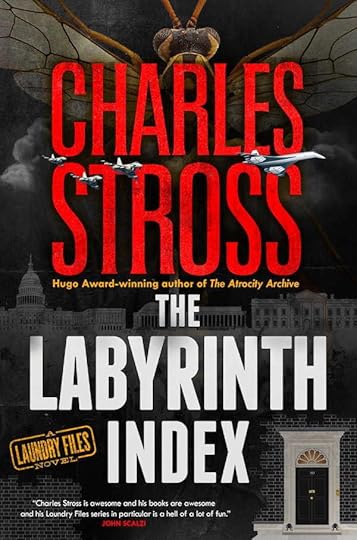 For those who have been with me on More Red Ink over the long haul, you know that I have been involved in all nine volumes of the Laundry Files series by Charles Stross: acquiring the first two volumes for Golden Gryphon Press, then working on volumes three through seven for Ace Books, volume eight for Macmillan UK, and the current volume,
The Labyrinth Index
[image error], for Tor/St. Martin's Press. [1]
For those who have been with me on More Red Ink over the long haul, you know that I have been involved in all nine volumes of the Laundry Files series by Charles Stross: acquiring the first two volumes for Golden Gryphon Press, then working on volumes three through seven for Ace Books, volume eight for Macmillan UK, and the current volume,
The Labyrinth Index
[image error], for Tor/St. Martin's Press. [1]In preparation for the release of this latest volume, author Charles Stross presented, on Tor.com, a "five-minute orientation briefing before Human Resources take over for your induction paperwork. Please try to pay attention: there won’t be an exam, but your life may depend on it."
So if you are getting ready to read The Labyrinth Index and looking for a recap of what's gone on previously in the series, then look no further than Tor.com.
Speaking of which, when you read the "five-minute orientation" and you come upon the name " X-Division of the Special Operations Executive," just pretend it actually reads "Q-Division. (We won't remind Charlie that it's always been a "Q"....)
Q-Division (formerly Q Department in earlier volumes) – the Laundry’s official name; originally part of SOE during WWII.The Labyrinth Index was officially released on October 30 and is available from Amazon[image error], or your bookseller of choice.
---------------Footnote:
[1] You can read about my work on The Labyrinth Index in my blog post on April 8, 2018.

Published on November 17, 2018 15:00
November 1, 2018
October 22, 2018
Now Reading: What's Big and Purple and Lives in the Ocean? The Moby Grape Story by Cam Cobb
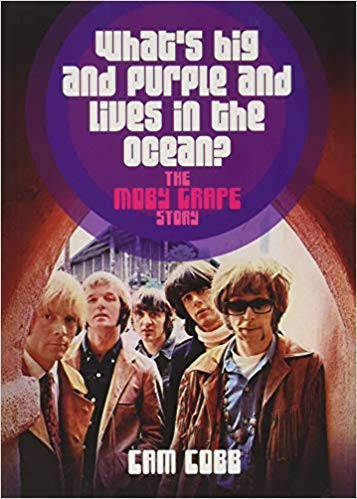 One of the premier San Francisco bands during the '60s was Moby Grape: 4 guitars (including bass) and drums, in which all 5 members of the band wrote original music and sang on one another's songs. One of the tightest, rocking bands in the entire San Francisco scene. They should have been big -- HUGE, in fact -- but the universe conspired against them. Of course, the immaturity of the band members themselves and the idiocy of the Columbia Records PR department didn't help any, either....
One of the premier San Francisco bands during the '60s was Moby Grape: 4 guitars (including bass) and drums, in which all 5 members of the band wrote original music and sang on one another's songs. One of the tightest, rocking bands in the entire San Francisco scene. They should have been big -- HUGE, in fact -- but the universe conspired against them. Of course, the immaturity of the band members themselves and the idiocy of the Columbia Records PR department didn't help any, either....The band was originally formed by manager/promoter Matthew Katz and musician Alexander "Skip" Spence, both previously associated with the Jefferson Airplane.
When the band finally signed with Katz, they should have read the fine print in the contract. And they also should have consulted a lawyer. (Not that any bands did in the '60s....) Katz had gotten them regular gigs at The Ark club in the Bay Area, and they were satisfied with his efforts and just happy to be performing regularly, so they signed the agreement without hesitation. But when they signed that agreement, unbeknownst to them, they also signed away ownership of the name "Moby Grape" to Katz. That clause would come back to bite them in the ass big time.
The entire history of Moby Grape has been thoughtfully written by Cam Cobb in his book What's Big and Purple and Lives in the Ocean? [image error] (Jawbone Press, 2018). Cobb has interviewed the surviving band members, plus he has pulled together previous interviews from other sources, and he has placed the events surrounding Moby Grape within the history of that time and place.
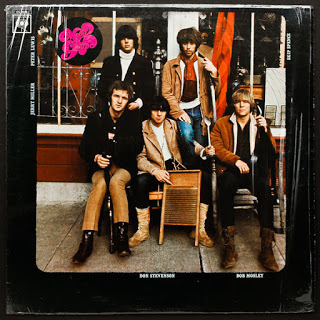 For the cover of their first Columbia Records album, simply titled Moby Grape, the band drove around various Bay Area locales for hours, with their photographer, trying to find just the right setting. And by the time they finally did find that perfect setting, Don Stevenson was so burnt out and pissed off, that he gave "the finger" during the photo shoot. In addition, the band selected an American flag as a prop in the scene, but given that this was 1967, the era of the Vietnam War, the Columbia Records execs got skittish and painted the flag in orange so that it wouldn't stand out. Later, after the album was released, and these very same execs saw "the finger" on the cover, they had the finger air brushed out on future cover printings. The original release also came with a fold-out 22-inch x 28-inch poster of the front cover, with Don Stevenson's "finger" in all its. glory.
For the cover of their first Columbia Records album, simply titled Moby Grape, the band drove around various Bay Area locales for hours, with their photographer, trying to find just the right setting. And by the time they finally did find that perfect setting, Don Stevenson was so burnt out and pissed off, that he gave "the finger" during the photo shoot. In addition, the band selected an American flag as a prop in the scene, but given that this was 1967, the era of the Vietnam War, the Columbia Records execs got skittish and painted the flag in orange so that it wouldn't stand out. Later, after the album was released, and these very same execs saw "the finger" on the cover, they had the finger air brushed out on future cover printings. The original release also came with a fold-out 22-inch x 28-inch poster of the front cover, with Don Stevenson's "finger" in all its. glory.The album was released on June 6, 1967, in both mono (CL 2698) and stereo (CS 9498); Sundazed Music reissued the album on both CD and LP (in mono) in 2007, but both reissues are currently out of print as well.
Author Cam Cobb on that first Grape album:
....It isn't simply an album of contrasts, however. It's a dialogue. The songs unfold in a sequence that represents a lyrical and stylistic conversation. The singers dialogue with one another from song to song, and within the songs themselves. As the album charges forward, it's filled with sharp, unexpected turns in speed and style, jumping from one genre to another, blending genres, changing tempo, changing key, and all the while holding everything together. It's an album of alchemy and exuberance. Moby Grape is an album made by five musical alchemists–six if we include producer David Rubinson. It's also an album of joyful exuberance, from the first note played on the guitar, and the first moment the band starts to sing. This is one of those rare albums that's both of its time and timeless.But back to Columbia Records and 1967: At the time, the Beatles were dominating the singles chart simply because their songs were so strong, so popular, that they remained in the Top Ten for many weeks. Columbia's PR idiots thought that they could duplicate this phenomena by releasing five singles off the Moby Grape album simultaneously (that's ten of the album's twelve songs), thus being able to dominate the charts. The problem they didn't anticipate is that radio stations, receiving five singles at once, didn't know which one to play, and some stations chose not to play any Grape singles at all. Does the word "overhyped" come to mind? The singles essentially bombed, and the overhype resulted in the album receiving a number of undeserved mediocre reviews.
Rock critic Paul Williams [1], editor of Crawdaddy magazine, wrote the following in the June 1967 issue:
Well, it took me a long time, but I finally figured out who Moby Grape remind me of: The Everly Brothers. Also Buddy Holly, Buffalo Springfield, middle-Beatles, Byrds, New Lost City Ramblers, The Weavers, Youngbloods , Daily Flash, and everybody else. Above all, the Grape give off this very pleasant sense of déjà vu. Rock has become so eclectic you can't even pick our influences–you just sense their presence. I don't really know why the Grape remind me of The Everly Brothers. But it's a nice feeling. Moby Grape is one of those beautifully inextricable groups with four guitarists (including bass), five vocalists, five songwriters, and about twelve distinct personalities (Skip Spence alone accounts for five of them). The Grape is unusual for an SF group in that it does not have an overall, easily identifiable personality from song to song. Their music is always unified; it's their album as a whole that's schizoid. In fact, much as I like it, I enjoy the songs even more one at a time (for your convenience, Columbia has issued almost the entire album on singles–which is particularly nice because the mono mix is far better than the stereo, which must have been done too fast).Ten days after the release of Moby Grape, the band arrived at the Monterey International Pop Festival, having been invited earlier to perform that weekend. This is the festival that introduced the world to Otis Redding, The Who, Janis Joplin, and, of course, Jimi Hendrix. The Grape had one of the coveted Sunday slots until, that is, their manager Matthew Katz had words with two of the promoters of the festival, record producer Lou Adler and John Phillips (of The Mamas & The Papas). Katz wanted over a million dollars for Moby Grape's appearance in the film that the promoters were shooting during the festival. Not only did he and the band not get their million, but the promoters got so pissed at Katz they demoted the band to the opening slot of the entire festival, when attendees were still being seated, etc. And not only did the band not appear in the film, but their set wasn't including in the official audio release of the festival either. In fact, it wasn't until 2010 that some of the songs from the band's Monterey performance finally appeared on a "Live" compilation release from Sundazed Music.
This misstep by Matthew Katz, along with other ongoing issues, finally led the band to sever its relationship with their manager. The problem, however, was the ownership of the band's name as previously mentioned. Within a few months, Katz was managing -- and promoting -- another band by the name of "Moby Grape."
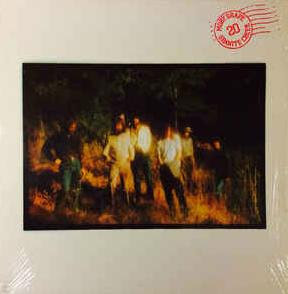 Venues were booking this bogus "Moby Grape" thinking it was the original band. Lots of confusion and frustration ensued for the band, for promoters, for venues. The situation got so bad that some venues started advertising the original Moby Grape as the "Columbia Records Recording Sensation" as a way of convincing ticket buyers that this was the "real" band.
Venues were booking this bogus "Moby Grape" thinking it was the original band. Lots of confusion and frustration ensued for the band, for promoters, for venues. The situation got so bad that some venues started advertising the original Moby Grape as the "Columbia Records Recording Sensation" as a way of convincing ticket buyers that this was the "real" band.Cam Cobb actually begins the first chapter of What's Big and Purple and Lives in the Ocean? with a discussion of Moby Grape's first reunion album, 20 Granite Creek [2], which was released by Reprise Records (the band was no longer with Columbia Records) in 1971. Sort of a jump forward before starting at the beginning of the band.
During one of Cobb's many interviews with Grape guitarist Jerry Miller, Miller had this to say about the band:
See, what we had with the Grape, the whole idea–I never had the idea of playing with three guitars before Moby Grape. And then, if you've got three blues guitars, it doesn't work. But we had Peter, who played the nice flngerpicking beautiful stuff. And Skippy would lay down this awesome rhythm. He put the palm of his right hand on the strings back by the bridge, and when he'd play it would give kind of a popping sound. They used to do that a lot in Texas. It gives a good percussion effect.
Bob and Don were tight with the drums and bass. Then Skippy would build the next rhythm level. Then Pete would play some pretty flngerpicking stuff, and I'd figure out how to glue them all together. With some little hot licks, some blues licks, and a few little jazz licks. You couldn't put three blues guitar players together and make it that easy. But it was easy, because nobody stepped on each other's toes.
---------------Footnotes:
[1] Paul Williams, a personal acquaintance of mine, passed away on March 27, 2013. I did a relatively brief memorial blog post on April 16 of that year, in which I link to some major newspaper obits. Paul was an amazing individual, and if you're not aware of all that he accomplished in his too-short life, please check out this post.
[2] 20 Granite Creek -- a century-old mansion -- was the address in the Santa Cruz (California) mountains where Moby Grape holed up to record the album of the same name. The front cover of the album was designed to look like a postage stamp, with the band name and album title in the cancellation mark.

Published on October 22, 2018 19:44
October 14, 2018
Clinton Heylin's The Great White Wonders - 1994 Original British Hardcover, Mint - on eBay
See my listing on eBay for the original 1994 Viking UK British hardcover edition of Clinton Heylin's history of rock music bootleg recordings: The Great White Wonders.

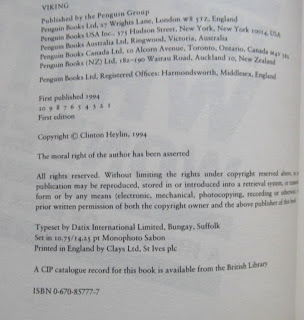




Published on October 14, 2018 15:29
October 11, 2018
September 28, 2018
Read Chapter 1 of The Labyrinth Index by Charles Stross
 In my blog post on April 8 I wrote about my work on the newest Laundry Files novel,
The Labyrinth Index
[image error] -- volume 9 -- by author Charles Stross.
In my blog post on April 8 I wrote about my work on the newest Laundry Files novel,
The Labyrinth Index
[image error] -- volume 9 -- by author Charles Stross.You can now read the entire Chapter 1, courtesy of the author and Tor.com. I'm going to post the first few paragraphs here, and -- assuming you are intrigued by the story line as much as I am -- simply click on the link following this excerpt to be whisked away to the full chapter on Tor.com.
By the way, the POV speaker is Mhari Murphy. You may want to read my blog post first, the one mentioned above, before reading the excerpt.
Chapter 1
As I cross the courtyard to the execution shed I pass a tangle of bloody feathers. They appear to be the remains of one of the resident corvids, which surprises me because I thought they were already dead. Ravens are powerful and frighteningly astute birds, but they’re no match for the tentacled dragonspawn that the New Management has brought to the Tower of London.
These are strange days and I can’t say I’m happy about all the regime’s decisions—but one does what one must to survive. And rule number one of life under the new regime is, don’t piss Him off.
So I do my best to ignore the pavement pizza, and steel myself for what’s coming next as I enter the shed, where the client is waiting with the witnesses, a couple of prison officers, and the superintendent.
Executions are formal occasions. I’m here as a participant, acting on behalf of my department. So I’m dressed in my funerals-and-court-appearances suit, special briefcase in hand. As I approach the police checkpoint, a constable makes a point of examining my warrant card. Then she matches me against the list of participants and peeks under my veil before letting me inside. Her partner watches the courtyard, helmet visor down and assault rifle at the ready.
Continue reading....

Published on September 28, 2018 16:52
August 26, 2018
Now Reading: And on Piano...Nicky Hopkins by Julian Dawson
 I've been reading
And on Piano...Nicky Hopkins
[image error] by Julian Dawson (Plus One Press, 2011). Actually, this is my second read-through this year alone of this "extraordinary" biography of "The Extraordinary Life of Rock's Greatest Session Man." That's the subtitle of the book, by the way, and as I read about Nicky Hopkins, I can only shake my head in wonder and awe at the mark this incredible musician has made on the history of rock music.
I've been reading
And on Piano...Nicky Hopkins
[image error] by Julian Dawson (Plus One Press, 2011). Actually, this is my second read-through this year alone of this "extraordinary" biography of "The Extraordinary Life of Rock's Greatest Session Man." That's the subtitle of the book, by the way, and as I read about Nicky Hopkins, I can only shake my head in wonder and awe at the mark this incredible musician has made on the history of rock music.But I wouldn't be surprised if readers of this blog post have never even heard of Nicky Hopkins. And though you may not have heard of him, I have to believe that if you listen to rock music regularly (not dance music, not R&B music, not metal or electronic music, but ROCK music), then you have, indeed, heard him.
Let's see...Do you recognize any of these songs? The Rolling Stones' "Jumpin' Jack Flash" and "Street Fighting Man." The Beatles' "Revolution." John Lennon's "Imagine" and "Happy Xmas (War Is Over)." George Harrison's "Give Me Love (Give Me Peace on Earth)." Jefferson Airplane's "Volunteers" and "We Can Be Together." And Joe Cocker's "You Are So Beautiful."
As you may have guessed, Nicky Hopkins was behind the piano on each of these best-selling singles, just a few of the hundreds of singles, and albums, on which he appeared. In fact, at the end of the book, the author presents a Nicky Hopkins Discography -- 28 small-print pages listing all the albums, singles, live performances, and film soundtracks on which the pianist performed.
Here's a YouTube vid of the man at work:
In the book, Julian Dawson shares a story: while Nicky was touring outside the U.S. someone began impersonating him at various recording studios. Once word got out about this impersonator, session producers learned to ask "Nicky Hopkins" to play his song "Edward," which would reveal soon enough if this person was indeed the real Nicky Hopkins. This is an audio-only vid featuring the song "Edward (The Mad Shirt Grinder)," which Nicky wrote while a member of Quicksilver Messenger Service, for their album Shade Grove (Capitol Records, 1969) -- however, this vid is a live performance of Quicksilver at Stony Brook College, New York, in 1970. A studio recording can always be overdubbed, etc., but one can't overdub a live performance:
Nicky was born in Middlesex, England, on February 24, 1944, during an air raid! He suffered throughout his entire life with health issues, most likely caused by an undiagnosed (at the time) case of Crohn's disease. In fact, at age 19, he spent more than a year in the hospital, recovering from a life-threatening illness from which the doctors never expected him to survive. And, sadly, he passed away at the age of 50, on September 6, 1994, in Nashville, Tennessee, from complications from that life-long battle with the disease.
John York, formerly with The Byrds, from the book:
"I gave [Nicky] a ride to a Jack Bruce session and when we got there Ginger Baker was just leaving. The engineer asked [Nicky] to go in and get a sound and Nicky started playing...and we all sat there and listened to him playing. It was when he was working on music for films and it was like listening to Rachmaninoff or something; at a certain point Nicky stopped, took a last drag on his cigarette, put it out, and said, "OK, mate," and then started playing like some 65-year-old Black guy from the Delta. It was unreal."
Julian Dawson, from the book:
"Nicky delivers one of the most elegant and perfectly conceived performances of his career on Let It Bleed's quietest track, "You Got the Silver." Keith Richards' love song to Anita Pallenberg was his first outing as sole lead vocalist and his heartfelt singing, acoustic slide and guitar tracks are perfectly underpinned by Nicky's understated organ and gentle piano. Over the years Nicky often referred to the song as one of his top five favourite performances, a sentiment echoed by Keith and others...."
And one last, albeit lengthy, quote from Julian Dawson:
"Imagine the voodoo groove of the Rolling Stones' 'Sympathy for the Devil' without its driving piano, 'Angie' or 'She's a Rainbow' without their gorgeous fills; the Beatles' 'Revolution' without its perfectly formed solo or the Who's explosive first album without its breakneck keyboard accompaniment. Picture Joe Cocker singing his hit 'You Are So Beautiful' alone and a capella, or try to imagine the strident call-to-arms that is Jefferson Airplane's 'Volunteers' without its keyboard riffs. Imagine...well, 'Imagine' stripped of its beautiful piano work; Lennon's 'Crippled Inside' without the perfectly tailored honky-tonk flourishes or 'Jealous Guy' without its haunting and delicate piano decorations. These are just a handful of classic tracks all played by one man's hands."

Published on August 26, 2018 16:57
July 30, 2018
Now Reading: Backstage Passes & Backstabbing Bastards by Al Kooper
 This book was originally published in hardcover as just Backstage Passes in 1977, covering the years 1958-1968. You may think, What could Al Kooper have done, between the ages of 14 and 24, that demands an entire book?
This book was originally published in hardcover as just Backstage Passes in 1977, covering the years 1958-1968. You may think, What could Al Kooper have done, between the ages of 14 and 24, that demands an entire book?Al Kooper scored his first professional gig at the very young age of 14 as a guitarist in the band the Royal Teens. He later joined the avant-garde blues-rock band Blues Project as a keyboardist in 1965; and after leaving that band, he then formed his own band, Blood, Sweat & Tears, in 1967. And let's not forget the Monterey Pop Festival, also in 1967, and something called Woodstock in 1968....
Let's see, what else: Al Kooper co-wrote the #1 pop song "This Diamond Ring," recorded by Gary Lewis and the Playboys when, I believe, he was just 20 years old. When Bob Dylan went electric in 1965 at the Newport Folk Festival, that was Al Kooper on the stage, playing Hammond organ in Bob's backing band. Kooper had just finished working with Dylan on the recording session for his iconic song "Like a Rolling Stone," so Dylan asked Kooper to join his backing band at Newport.
Following the festival, Kooper then went on to play on the sessions for the rest of Dylan's highly successful album Highway 61 Revisited. Al Kooper was 21. (Note: During those recording sessions, Al Kooper met guitarist extraordinaire Michael Bloomfield; the two later recorded together the albums Super Session and The Live Adventures of Mike Bloomfield and Al Kooper, both in 1968.)
Speaking of the recording session for "Like a Rolling Stone," Al Kooper actually bluffed his way into that session -- he had never previously played a Hammond organ until then. Here's just a bit of what he writes about that experience:
"Imagine this: There is no music to read. The song is over five minutes long, the band is so loud that I can't even hear the organ, and I'm not familiar with the instrument to begin with. But the tape is rolling, and that is Bob-fucking-Dylan over there singing, so this had better be me sitting here playing something. The best I could manage was to play hesitantly by sight, feeling my way through the changes like a little kid fumbling in the dark for the light switch. After six minutes they'd gotten the first complete take of the day and everyone adjourned to the control room to hear it played back.So, what do you think? Is that ten-year span sufficient to fill a book? And though I've mentioned just the cursory points, the author goes into depth on the bands and musicians, the songs, the sessions, the cities and the places, and the events of the day.
...
If you listen to it today, you can hear how I waited until the chord was played by the rest of the band, before committing myself to play in the verses. I'm always an eighth note behind everyone else, making sure of the chord before touching the keys...."
Twenty years after this book had been published, and long since out of print, Al Kooper found a new publisher willing to reprint the book as a trade paperback. But, the author chose to revise those first ten years (with more pointed detail) as well as adding his personal experiences over the next thirty years. And with the reprint came a new, more descriptive title: Backstage Passes & Backstabbing Bastards: Memoirs of a Rock 'N' Roll Survivor [image error].
But wait, there's more! The book was reprinted yet again, in 2008, to cover additional years from 1998 through 2007. Al Kooper had to deal with some very serious health issues by this time, which he faced with aplomb.
According to Wikipedia, Al Kooper had a sixty-eighth birthday celebration at the Regatta Bar in Cambridge, Massachusetts, on February 4, 2012. And, I assume, Kooper is still performing to this day.
"...The other amazing thing about cutting that album [Bob Dylan's Blonde on Blonde] was the firsthand knowledge that you were making history. After I cut the Highway 61 Revisited album, I heard those songs everywhere. I will probably hear them all my life, anywhere I go. They were instant classics because they were prime Dylan. Imagine how it felt playing on a session where, by virtue of the fact that you had already done it once before, you knew that whatever you played would last forever. That's a heavy responsibility for a punk from Queens. Thank you, Bob, for giving me that opportunity."
–Al Kooper, Backstage Passes & Backstabbing Bastards
Here are a few album recommendations for those who might like to pursue the music of Al Kooper -- most, but not all, should be available on CD (and again, I can't speak to streaming as I prefer the physical media). By the way, this list is excerpted from a full eight pages of Kooper's body of work.
As musician–
The Best Of The Blues Project (Rhino Records, 1989)Blood, Sweat & Tears - Child Is Father To The Man (Columbia, 1968)Al Kooper - I Stand Alone (Columbia, 1968)Mike Bloomfield / Al Kooper / Stephen Stills - Super Session (Columbia, 1968)The Live Adventures Of Mike Bloomfield And Al Kooper (Columbia, 1968)Soul Of A Man: Al Kooper Live (MusicMasters, 1995, 2-CD)
As producer/arranger–
Lynyrd Skynyrd – (Pronounced 'Lĕh-'nérd 'Skin-'nérd) (MCA/Sounds of the South, 1973)Lynyrd Skynyrd – Second Helping (MCA/Sounds of the South, 1974)The Tubes (A&M, 1975)Nils Lofgren - Cry Tough (A&M, 1976)I would have included some of Al's more recent works but, sadly, they saw limited release and are currently out of print. His last (so far) solo album, White Chocolate (A Minor Record Company, 2008) would certainly have been on this list.

Published on July 30, 2018 20:14
July 22, 2018
Now Reading: This Wheel's on Fire by Levon Helm with Stephen Davis
 He was born Mark Lavon (yes, with an "a") Helm on May 26, 1940, but somewhere along the way, once he started touring and playing music, he became "Levon" (pronounced "Lee-von") Helm. The subtitle of
This Wheel's on Fire
[image error] is "Levon Helm and the Story of The Band." If you have to ask, "What band?" then you don't know your classic rock music, and you certainly aren't a fan of Bob Dylan's body of work.
He was born Mark Lavon (yes, with an "a") Helm on May 26, 1940, but somewhere along the way, once he started touring and playing music, he became "Levon" (pronounced "Lee-von") Helm. The subtitle of
This Wheel's on Fire
[image error] is "Levon Helm and the Story of The Band." If you have to ask, "What band?" then you don't know your classic rock music, and you certainly aren't a fan of Bob Dylan's body of work.Then again, if you are a moviegoer, you just might have seen Levon in the role of the coal miner, Ted Webb, in the 1980 screen adaptation of Loretta Lynn's autobiography Coal Miner's Daughter. He also played the role of Captain Jack Ridley, friend and fellow conspirator of Chuck Yeager in the film The Right Stuff. [I have watched this movie on numerous occasions (still have it on a double VHS!) and absolutely never realized that Ridley was played by Levon Helm....]
But back to the music: This is the story of how five musicians -- four Canadians and one Arkansawyer, multi-instrumentalists all -- came together over a span of years and endless road touring to eventually form The Band. To be honest, they never called themselves "the band" as they always thought this to be too pretentious: they were five individual musicians, each of whom went by their own name. But, while living in the Woodstock area of New York, the townfolk would simply refer to them as "the band": "Oh, he's in the band." And when their first album, Music From Big Pink, was released, they became The Band.
What motivated me to finally [see next to last paragraph] pick up this book and actually read it straight through? Believe it or not, this year marks the 50th anniversary of the release of Music From Big Pink (gawd, 50 years?), and the remaining two members of the band have opted to release a 50th Anniversary edition of this seminal work: a box set as well as a newly remastered (from the original analogue tapes) double-LP on pink vinyl.
Levon Helm writes:
"We wanted Music From Big Pink to sound like nothing anyone else was doing. This was our music, honed in isolation from the radio and contemporary trends, liberated from the world of the bars and the climate of the Dylan tours. We'd grown up with Ronnie Hawkins [Ronnie Hawkins and the Hawks], playing that quicker tempo of tunes. Now we cut our tempo, our pulse, right in half. The sense of teamwork and collaboration was incredible. Robbie [Robertson, vocals, guitar] was writing stuff that evoked simple pictures of American life. Richard [Manuel, vocals, keyboards, drums] was writing beautiful songs like 'In a Station' and 'Lonesome Suzie.' Garth [Hudson, keyboards, accordion, brass and woodwinds] took a great song like 'Chest Fever' and composed an organ prelude. Rick's [Danko, vocals, bass, fiddle, trombone] playing and singing were amazing, and that blend of the three voices -- Richard, Rick, and me -- sounded really rich after we'd worked with John Simon [producer] for a while."
And the reviews for Big Pink, to use Levon's own words, were "pretty good." Al Aronowitz, in Life magazine: "With Big Pink, the band dips into the well of tradition and comes up with bucketsful of clear, cool country soul that washes the ears with a sound never heard before. Traditionalists may not like it because it's too original. Pop faddists won't like it because it's too traditional." And in Rolling Stone, Al Kooper wrote: "I have chosen my album for 1968. Music From Big Pink is an event and should be treated as one....This album was recorded in approximately two weeks. There are people who will work their lives away in vain and not touch it."
I could go on and on with reviews of Big Pink as well as their follow-up album, simply called The Band, but I'd rather not overwhelm you with facts and opinions, but simply recommend a few albums if, indeed, you are not familiar with the music:
Music From Big Pink (1968)The Band (1969)Bob Dylan/The Band - Before the Flood (1974)Bob Dylan & The Band - The Basement Tapes (1975)Northern Lights - Southern Cross (1975)Levon Helm - Dirt Farmer (2007, Grammy Award for Best Traditional Folk Album)Levon Helm - Electric Dirt (2009, Grammy Award for Best Americana Album)
I've been reading the 1993 hardbound edition of this book, which I've had in my library, well, since 1993(!), but while looking the title up on Amazon I have learned that Chicago Review Press published a trade paperback edition in 2000, and then a "Revised Edition" in 2013. If you are intrigued by my post and decide to pursue your own reading copy, try to snag the 2013 revised edition as it contains an additional chapter as well as an afterword, neither of which are in my copy. Levon Helm passed away in 2012, so these additions may include the last words we'll every hear from him.
"They were grown men who had climbed the mountain together, spoken to the gods, and returned to the valley, where they once again became mortal."– The Philadelphia Inquirer

Published on July 22, 2018 12:47
July 10, 2018
Now Reading: Michael Bloomfield: The Rise and Fall of an American Guitar Hero by Ed Ward
"The music you listen to becomes the soundtrack of your life. It may be the first music you made love to or got high to or went through your adolescence to, went through poignant times of your life—well, that music is going to mean a lot to you. It's going to take on much more import than just the sound of the notes, because it's the background track for your existence."– Michael Bloomfield, in an interview with
Tom Yates and Kate Hayes, February 13, 1981.
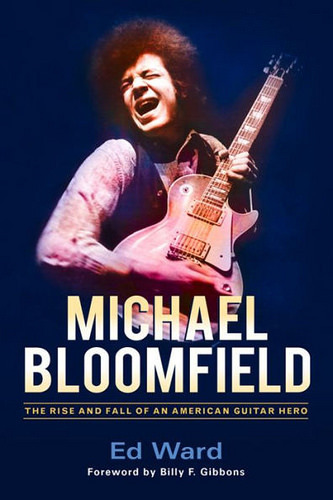 At 11:00 a.m. on February 15, 1981, Michael Bloomfield was found slumped over the steering wheel in his parked car, keys still in the ignition, in a part of San Francisco in which he never frequented. The pathologist ruled the cause of death as cocaine and methamphetamine poisoning -- very odd, considering that Michael never touched cocaine, and as a lifelong insomniac, why would he intentionally take two drugs that keep one awake? Questions, sadly, that will never be answered.
At 11:00 a.m. on February 15, 1981, Michael Bloomfield was found slumped over the steering wheel in his parked car, keys still in the ignition, in a part of San Francisco in which he never frequented. The pathologist ruled the cause of death as cocaine and methamphetamine poisoning -- very odd, considering that Michael never touched cocaine, and as a lifelong insomniac, why would he intentionally take two drugs that keep one awake? Questions, sadly, that will never be answered.Fortunately, we still have his music....
When Bob Dylan went electric at the 1965 Newport Folk Festival, Michael Bloomfield was on that same stage, backing Dylan on guitar. This was three days before Michael's twenty-second birthday. Here's what Ed Ward wrote about that performance:
"During 'Maggie's Farm,' Bloomfield becomes Dylan's second voice. He sits so hard on top of the beat that it screams, and what he plays amounts to a sardonic running commentary on Dylan's song. Bloomfield approaches atonality in a couple of places, but his playing on 'Maggie's Farm' sits squarely within the blues tradition. It's not hard to understand why some people in the audience were confused, because what Bloomfield gave them on the evening of July 25, 1965, was the future of rock guitar."
Following Newport, Bloomfield then played on the Dylan recording sessions, along with Al Kooper who also played at Newport, for the album Highway 61 Revisited [image error], released by Columbia Records later that year.
In addition to Highway 61 Revisited, here are a few "must have" albums that showcase Michael Bloomfield's work. I assume most, if not all, of these albums are available for streaming, but that's not my thing. Personally, I want the physical media, and the larger (i.e. vinyl) the better:
The Paul Butterfield Blues Band self-titled album (1965)The Paul Butterfield Blues Band - East-West (1966)The Electric Flag - A Long Time Comin' (1968)
Mike Bloomfield, Al Kooper, Steve Stills - Super Session (1968)The Live Adventures of Mike Bloomfield and Al Kooper (1969)Michael Bloomfield and Friends - Live at Bill Graham's Fillmore West 1969Nick Gravenites - My Labors (1969)Muddy Waters - Fathers and Sons (1969)
Michael Bloomfield, to Ed Ward, on why he chose not to tour with Dylan following the release of Highway 61 Revisited:
"With Bob, I'd have no identity. I didn't even know that [at the time]. All I knew was that I didn't understand what was happening....So I told Albert [Grossman, Dylan's manager], 'Man, I'm a bluesman. I'll go with Butterfield.' And I played with Butter and didn't play with Dylan, and we were cookin'. We wailed from then on."
Michael Bloomfield: The Rise and Fall of an American Guitar Hero [image error] by Ed Ward (Chicago Review Press Inc., 2016, Revised Edition).

Published on July 10, 2018 19:56





